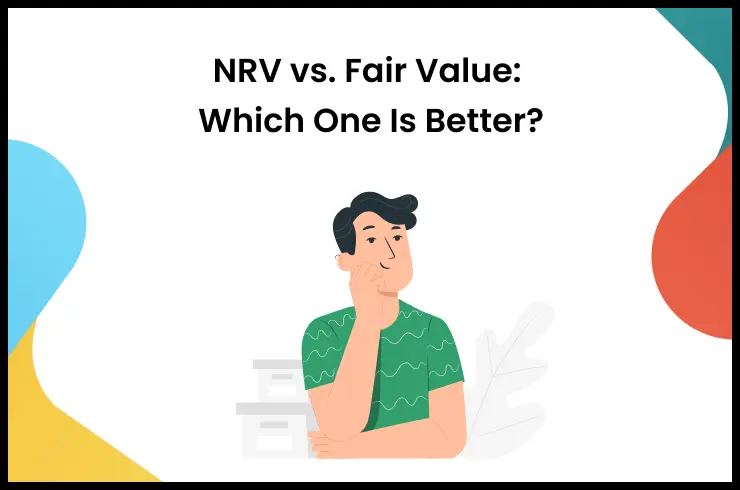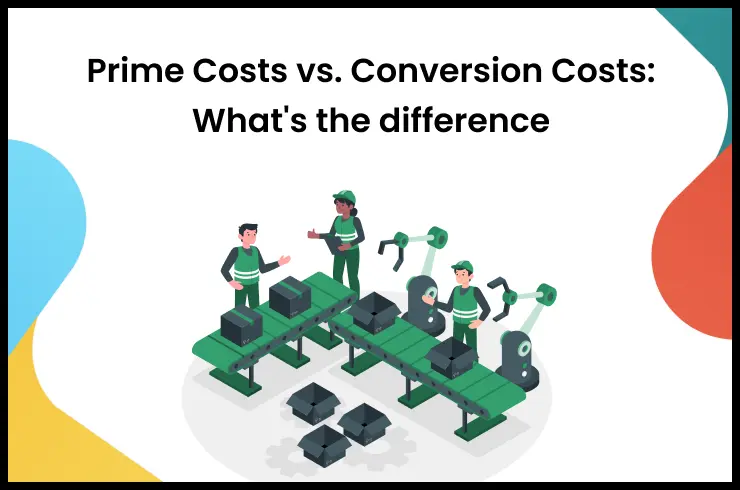The exact valuation of available raw materials, finished goods, and accounts receivables are very important for small-scale manufacturing businesses to make better financial decisions. Net Realizable Value (NRV) and fair value are the two popular methods that you can use to evaluate the actual value of your assets. However, when it comes to choosing between Net Realizable Value (NRV) vs Fair Value it can be confusing. Both methods offer different approaches, and selecting the right one can have a significant impact on how your financial health is represented. Without a proper understanding of these valuation techniques, businesses risk misrepresenting their assets, which can lead to poor decision-making and financial setbacks. So, which method is truly better for your business?
In this blog post, we will learn about both net realizable value and fair value to improve your financial planning and profits in your manufacturing business.
Understanding Net Realizable Value (NRV)
The simple net realizable value definition is the amount you can get by selling your products after subtracting the costs involved in production and shipments. Knowing net realizable value meaning helps you use this method to improve your accounting processes. You write NRV in your balance sheets to analyze the reduced values of your products so that you can make better financial decisions for your business. Let’s learn about the net realizable value in detail so that you can use it according to your unique requirements.
NRV In Inventory
Calculating the net realizable value of inventory items is common in manufacturing businesses.
- It helps you estimate the real prices of your inventory items after analyzing if they are damaged or outdated.
- It helps you record the realistic valuation of your products and improve visibility over your business profitability.
- You can analyze net realizable value inventory records to identify processes that contribute to reducing the value of your products over time.
Lower of Cost and Net Realizable Value
Lower of cost and net realizable value methods help you find out actual prices for which your products can be sold, even if they are lower than the original costs. Let’s understand this with a lower of cost and net realizable value example. Suppose you have finished goods of Rs. 10,000 in your warehouse, but they can be sold for Rs. 9,000 only because their season is gone. Now, the actual amount of your finished goods will be valued on the balance sheet at Rs. 9,000.
NRV In Accounts Receivable
Not all customers pay the total amounts they owe, and that’s why you use the net realizable value in accounting to improve visibility over your accounts receivables. It shows the actual amount you expect to receive from your customers. Let’s understand this with a net realizable value of accounts receivable example. Suppose you have delivered finished goods of Rs. 50,000 to a customer, but you don’t expect to collect the total amount. Suppose the doubtful amount is Rs. 10,0000. Let’s learn how to calculate net realizable value of accounts receivable with the formula.
- Total owed amount = Rs. 50,000
- Doubtful amount = Rs. 10,000
Use the net realizable value of accounts receivable formula: NRV of account receivable = total owed amount - doubtful amount.
- NRV of account receivable = 50,000 (total owed amount) - 10,000 (doubtful amount) = 40,000
- Your accounts receivable net realizable value is Rs. 40,000, which you expect to collect from your customer.
NRV Calculation
NRV calculation is easy and provides you with the true valuation of your assets. Let’s learn how to calculate net realizable value with simple steps.
- Identify the expected amount you can get by selling your products.
- Calculate the costs involved in the production, packaging, and delivering those products.
- Use the net realizable value formula: NRV = expected selling price - total production and shipment costs.
Here are examples of how to calculate NRV for inventory and accounts receivable. Calculating NRV for inventory.
- Suppose the expected selling price of a certain inventory item in your warehouse is Rs. 5,000
- The costs involved in the production and delivery of that product is Rs. 1500
- Put the data in the formula: NRV = 5,000 - 1500 = 3,500
- The NRV of that inventory item is Rs. 3,500.
Calculating NRV for accounts receivable.
- Suppose your customer owes Rs 10,000 for a previous procurement.
- You expect that Rs. 2,000 of that amount won’t be collected according to his/her previous transactions.
- Put the data in the formula: NRV = total owed amount - doubtful amount.
- Your NRV of accounts receivable = 10,000 (total owed amount) - 2000 (doubtful amount) = Rs. 8,000.
Understanding Fair Value
Fair value is the price at which your products or assets can be sold in the current market. According to this value, both buyer and seller are knowledgeable and willingly agree to make the deal. It is used in accounting to reflect the current value of assets. You can use fair value in accounting to improve visibility over your financial statements and understand your business’s position in the market to make informed decisions. This method is widely used in the stock market to set fair prices for shares. You can use the fair value of stock formula: [cash { 1 + r (x/360)} - dividends] to find out accurate prices. In this formula, cash is the current value of security, r is the interest rate for the broker, x is the days remaining in the contract, and dividends are the total dividends an investor would receive before the expiration date.
Fair Market Value
Fair market value is similar to fair value and reflects the price at which assets can be sold or purchased in the open market. The price is set by analyzing demands, current value, and other market conditions to make the deal fair for both buyers and sellers. There is no specific fair market value formula that can help you learn how to calculate fair market value. However, you can use different methods instead of using fair market value formula accounting to estimate accurate prices. Let’s understand it with a fair market value example. Suppose you own a manufacturing company and need to estimate the fair market value of your machinery, which isn't frequently traded. You can use several methods to calculate a fair price.
- You could compare the price of similar machines in the market (market approach).
- Or, you could estimate the future income that the machine will generate (income approach).
- Or, calculate the cost of replacing the machinery with similar equipment (cost approach).
All of these methods can help you calculate the fair market value in accounting and improve visibility over your investment in that start-up company.
Fair Value In Inventory
The fair market value of inventory is the prices of your products in warehouses that you can get by selling them according to the current market conditions. If the customer demands and market trends change, the fair market value of your inventory items also changes. It differs from the NRV of inventory, which usually stays steady during market fluctuations. You can calculate the fair value of inventory to improve accuracy in the current deal. On the other hand, you can value your inventory at lower costs by using NRV to make informed financial decisions for your business.
Fair Value Of Accounts Receivable
The fair value of accounts receivable is the prices you can get if you sell your receivables to someone else. To calculate this value, you can estimate how much money you can collect from your receivables in the future. You then discount it to the current value according to the market interest rates and other conditions. You can also compare this value with what other buyers would pay for your receivables to improve accuracy.
Fair Value Calculation
You have to analyze market trends and future demands of the assets to improve your fair value calculation. Find out current market prices to calculate the fair value of your inventory and accounts receivables. If the market price is not available, use methods like income, cost, and market approaches. If you want to calculate the fair value of shares, you can use the formula. Let’s take an example to calculate this. Suppose you want to calculate the fair value of your manufacturing equipment, which is priced at Rs. 10,00,000. You’ve taken a loan with an interest rate of 8%, and the contract expires in 60 days. The equipment generates revenue worth Rs. 20,000 in that time. You can calculate fair value using a formula like:
Fair value = [Price {1 + r (x/360)} - revenue]
In this case: Fair value = [10,00,000 {1 + 0.08 (60/360)} - 20,000] = Rs. 10,03,333.33.
NRV vs. Fair Value: Key Differences
The NRV vs fair value comparison helps you find the accurate valuation of your inventory, accounts receivables, and other assets. Let’s learn about the key differences between net realizable value and fair value.
| Net Realizable Value | Fair Value |
|---|---|
| It shows the approximate price you can get by selling your products minus selling costs. | It shows the amount you can get by selling your products or assets in the current market. |
| It values your inventory items at lower costs to improve visibility over your profits. | It values your inventory items according to market conditions and can be higher than the original costs. |
| It can be helpful for damaged and outdated products. | It can be helpful to improve accuracy in current deals. |
| It is used in accounting to make sure that assets are not overvalued. | It is used in accounting to value your assets in the current situations. |
| It shows the realistic amounts in financial statements that you can get for your inventory and accounts receivables. | It can show higher amounts in financial statements for your inventory and accounts receivables if the market is strong. |
Which Method Is Better?
Both NRV and fair value are useful methods for the valuation of your assets.
- You can use NRV in financial reporting to estimate realistic values of your assets.
- It prevents your investors from being misled and helps estimate profits or losses with accuracy.
- It helps you make long-term decisions and improve profits for your business.
On the other hand, fair value shows the current value of your assets in the financial reports according to market situations.
- It shows if you make profits or suffer losses in your deals right away.
- It helps you compare your asset’s value with others to improve accuracy in calculation.
- It also helps you make real-time decisions for your business according to your requirements.
Even though both methods are helpful, NRV can be best for inventory and accounts receivables, while fair value is more suited for the stock market, property mergers, and other market-based assets.
Improve Visibility Over Your Assets With TranZact
You can use both net realizable value and fair value methods to improve the valuation of your assets. One shows the estimated value of your assets without involving the selling costs, while the other helps you identify your assets’ value according to current market conditions. You can use this data to analyze the values of your inventory and accounts receivables to make informed decisions. You can also use tools to make the calculations easy and access quick data for analysis. TranZact is an easy-to-use tool developed for manufacturing businesses in India. It can help you improve visibility over your inventory, including raw materials, semi-finished goods, and finished goods. It helps you test the quality of procured materials and finished goods in the process, identify damages, and estimate accurate value. TranZact can improve visibility over your accounts receivables and send you alerts for overdue receivables so you can make quick and informed decisions. Implement TranZact in just 14 days.
FAQs
1. What is the difference between Net Realizable Value (NRV) and Fair Value?
Net realizable value (NRV) is the estimated price of your assets minus selling costs, while fair value is the price you can get by selling your assets in the current market.
2. How do you calculate the Net Realizable Value (NRV) of inventory?
To calculate the Net Realizable Value of inventory, identify the expected amount you can get by selling it and calculate the selling costs. Put the data in the formula: NRV of inventory = expected selling amount - selling costs.
3. When should NRV be used instead of Fair Value in accounting?
You should use NRV instead of fair value in accounting when estimating realistic prices for inventory and accounts receivables.
4. What is the formula for calculating Fair Value in accounting?
You can use the following formula to calculate the fair value in accounting for stocks: Fair Value = [cash {1 + r (x/360)} - dividends].
5. How does the 'Lower of Cost and NRV' principle apply to inventory valuation?
The “lower of cost and NRV principle” applies to inventory valuation to value assets at lower costs than their historical costs in the balance sheets. This shows the real financial picture of your business.
Q6. What is NRV in accounts receivables?
NRV in accounts receivables is the amount you expect to collect from your customers rather than the total amount owed.















